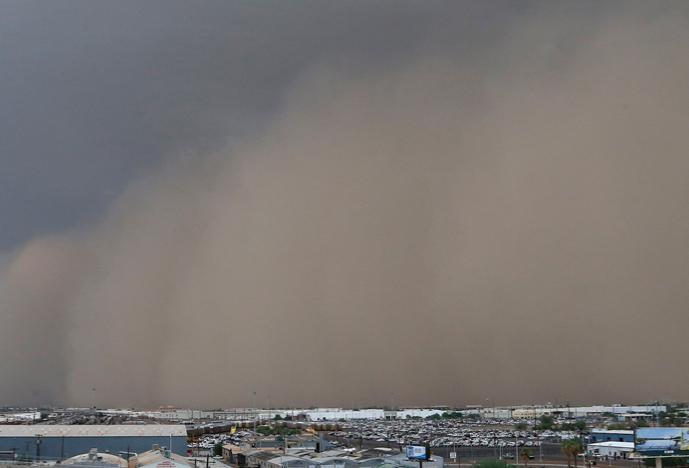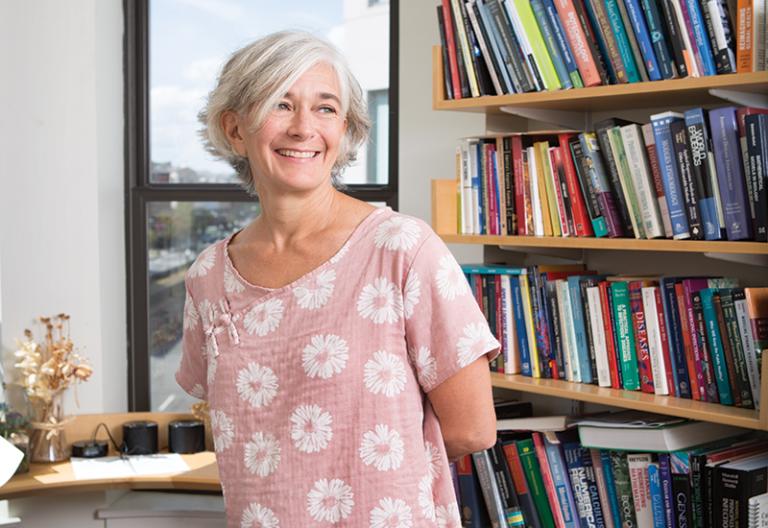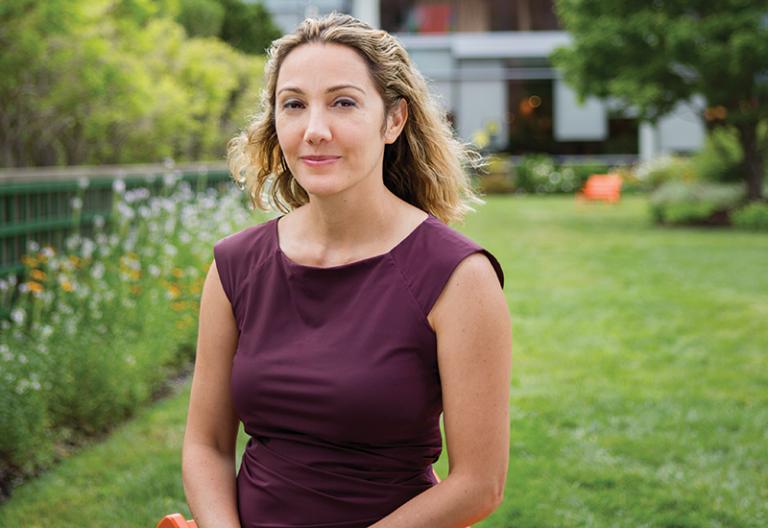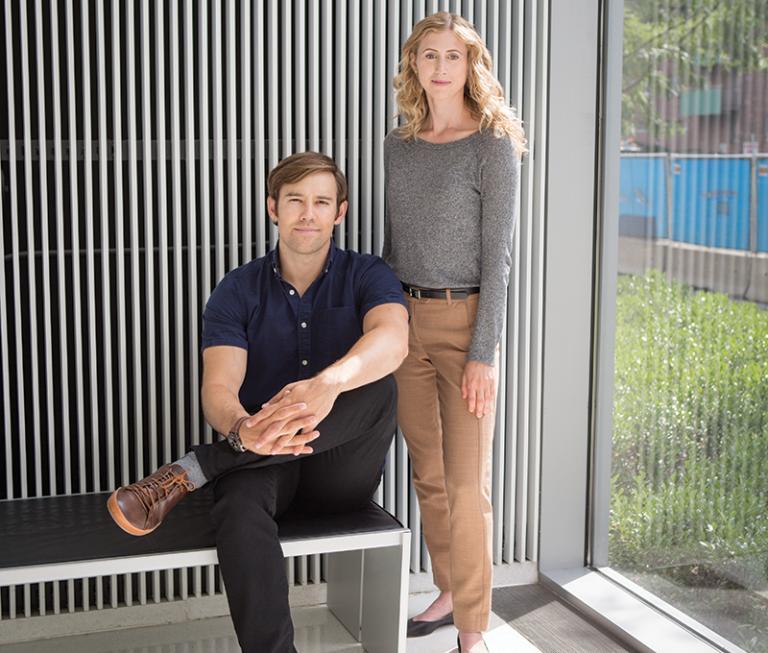Inherit the Wind
Changes in Earth’s climate are hurting our health and may well be dashing our hope to coexist peacefully
- 16 minute read
- Feature

The morning sun dimmed over Boston, and dust sifted down from the hazy yellow sky. At first people thought that what they were seeing was smoke and ash from a forest fire, but the Boston Daily Globe soon reported it was the last gasp of a storm that had whipped up more than 300 million tons of dirt from the Great Plains.
In New England, that May 1934 event was largely a novelty. But it was a grim reality from Texas to North Dakota, where thousands of people were suffocating on the fine, dry soil buffeted about by that dust storm and the hundreds of others that had pummeled the heart of the country for a decade. The wracking coughs, fevers, and body aches of “dust pneumonia,” a form of silicosis that clogs and irritates the lungs, killed some within days, particularly children and older adults, and left others debilitated for life.
Accounts such as The Worst Hard Time, written by New York Times columnist Timothy Egan, describe in heartbreaking detail how unsustainable farming practices, exacerbated by an eight-year drought, led to not only ecologic and economic devastation but also a flurry of health problems. People became malnourished and depressed. Eye, sinus, throat, and bronchial infections abounded. Measles and influenza swept through towns. Wind-driven dirt, lodged under eyelids, abraded corneas and caused blindness. Injuries and deaths from vehicular accidents spiked as visibility often dipped to near zero. Surgical facilities closed as dust pressed in.
The health consequences of the Dust Bowl are gaining new notice as experts on climate change predict that with increases in temperature and shifts in rainfall patterns, the world’s populations can expect more pervasive and intense droughts, and larger, more frequent dust storms. Dust storms, including intense ones called haboobs, doubled in the U.S. Southwest between the 1990s and early 2000s, leading to a surge in dust-related fatal car accidents, in respiratory ailments such as asthma, and in valley fever, caused by breathing in fungus stirred up from desert soils.
And it’s not just dust. Nearly all facets of climate change, from warming and rising seas to escalating extreme weather events, are damaging human health and behavior. In the United States alone, in the late summer and early fall of this year, West Coast residents experienced chart-topping temperatures and massive wildfires that caused widespread heat exhaustion and breathing difficulties and killed dozens. The series of hurricanes that struck the Gulf Coast and the Caribbean killed more than one hundred people and caused untold illnesses, including some among low-income residents who couldn’t afford to leave their mold-infested apartments after floodwaters receded or didn’t have access to safe drinking water for weeks.
Variables compound and complicate one another, sometimes in unexpected ways, and although vulnerable populations will continue to be disproportionately burdened, it’s becoming more difficult to find any place in the world where physical or mental health remains unassailed by changes in Earth’s climate.
Dominoes
“Climate change is a significant threat to the health of the American people,” begins The Impacts of Climate Change on Human Health in the United States: A Scientific Assessment, a 300-page report compiled by thirteen government agencies in 2016.
The report’s authors join other scientists in warning that changes to the climate will exacerbate environmental phenomena that put human health at risk. They say that natural disasters and the health hazards that accompany them will increase in frequency and severity, expand into new geographic areas, and strike at unprecedented times of year.

Some of these events directly affect health. People die during and after hurricanes, tornadoes, wildfires, floods, droughts, heat waves, deep freezes, and wild temperature and precipitation swings. Others are injured, fall ill, or get sicker, or are displaced, stressed, or traumatized. Air and water quality worsen while food and water availability decrease, provoking conditions such as asthma, cardiovascular stresses, malnutrition, and diarrheal illnesses.
Other health consequences may be less immediately apparent. Anthropogenic factors can affect health even as, or before, they influence changes in the climate. Higher concentrations of atmospheric carbon dioxide nourish plants that then release more allergens. Deforestation brings humans and animals into new or sustained contact that can spawn more cases of known or novel zoonotic diseases.
“We’re heading toward ecological disaster,” says Megan Murray ’90, the Ronda Stryker and William Johnston Professor of Global Health at HMS, director of the research core in the HMS Department of Global Health and Social Medicine, and a professor of epidemiology at the Harvard T.H. Chan School of Public Health. “It’s hard to even think about it as a health issue when we’re confronting the possibility of the destruction of our life on Earth.”
Known Unknowns
“In studying infectious disease, we usually focus our efforts on the fundamental biology of infectious agents, clinical care, and outbreak response,” says Pardis Sabeti ’06, a professor at Harvard University and at the Harvard Chan School and an institute member of the Broad Institute of Harvard and MIT. “Yet the history of the human genome reveals to us that one of the strongest pressures on human populations is a changing environment.”
Biomedical researchers are trying to close knowledge gaps in how humans are affected by changes in our environment and which health interventions work best. They are getting better at linking individual events to climate drivers, and they’re collecting data on health outcomes and constructing more accurate predictive models. But they have not yet mastered “what happens to human health and well-being when temperatures change, for example,” says Nick Obradovich, an associate at the Harvard Kennedy School’s Belfer Center for Science and International Affairs and at the Harvard University Center for the Environment. Doing so is necessary, he says, “so that we can determine where policy and monetary resources need to be placed, in addition to trying to prevent the worst climate outcomes.”
Moving In
In September 2014, Anne Piantadosi had just started her infectious disease training at Massachusetts General and Brigham and Women’s hospitals when a twenty-five-year-old man arrived with fever, rash, vomiting, and confusion. The cause: unknown.

“He was really sick and we couldn’t figure out why,” recalls Piantadosi, now an HMS instructor in medicine at Mass General.
Eventually, tests led to a diagnosis of encephalitis caused by Powassan virus, a rare tick-borne pathogen. Before 2013, only one case had been recorded in Massachusetts. From 2013 to 2015, however, there were eight patients diagnosed at Massachusetts hospitals.
In a 2016 paper in Clinical Infectious Diseases, Piantadosi and colleagues argue that although greater clinical recognition could account for a portion of the rising incidence, field observations suggest more people are becoming infected.
Piantadosi’s colleague Jacob Lemieux ’15, an HMS research fellow in medicine at Mass General, has watched local cases of Lyme disease and babesiosis, a malaria-like illness, climb as well. Like Powassan, these diseases are transmitted by deer ticks, also called blacklegged ticks, whose habitats are expanding in this country.
“There are just tons of tick-borne cases, more this season than I’ve ever seen,” says Lemieux.
The spike coincides with rising temperatures. The winter of 2015-2016 was the mildest on record for the planet, with 2016-2017 a close second. This spring, deer ticks emerged in a balmy New England a month earlier than usual. Experts warn that they could become a year-round problem in the region for people and animals.
Many climate scientists see more than a correlation. They say warmer and wetter trends mean longer transmission seasons and broader geographic ranges for diseases spread by ticks as well as those transmitted by mosquitoes and fleas. Vector-borne diseases previously confined to the tropics, such as Zika virus disease and Chagas disease, are invading the southern United States. Bugs once confined to the South, like the lone star tick, which can transmit a lethal allergy to red meat, are creeping north, and vectors usually found in lower elevations are appearing in the mountains.
Lemieux and Piantadosi confront the problem not only in the clinic but also as postdoctoral researchers in the Sabeti lab. There, they study the biology of viruses, bacteria, and parasites to learn how humans can protect themselves beyond bug spray and long-sleeved shirts. By analyzing the genomes of Babesia microti, Lemieux has mapped different strains across the United States and identified genetic variants that seem to correspond to relapsing forms of the illness. Genetic sequencing is likewise helping Piantadosi understand the population structure of Powassan viruses, how they grow and change, how they cause disease, and whether specific strains infect people. Both researchers hope their findings lead to treatments, vaccines, or improvements in vector control.
“A main focus of the lab is to create tools that empower every person to understand infectious disease spread and be part of the solution if an outbreak ever emerges,” says Sabeti. “This is one way of many that individuals can engage in fighting climate change.”
In the meantime, there is no treatment for Powassan encephalitis. Piantadosi’s patient was lucky: He recovered. Two of the other seven died and another two had lingering neurological and motor issues.
Steam Heat
In 2015, after months of toppled temperature and precipitation records, San Diego experienced the hottest week of its hottest-ever October. At nearly midnight in the apartment of Obradovich and Robyn Migliorini, then a neuropsychology graduate student, it was still in the mid-80s and oppressively humid. Migliorini sprawled like a starfish in bed, trying to cool off with a fan and a spray bottle. Obradovich lay awake beside her, sweating. Sleep was an impossibility.

They were not alone. The next morning, they noticed that classmates and colleagues were as tired and grumpy as they were. Their science radar pinged. The duo decided to combine Obradovich’s research on the politics of climate change with Migliorini’s psychology training, which included an interest in healthy and disordered sleep, and investigate whether changes in climate meant they were looking at a new normal for sleep.
Building on controlled sleep lab studies of ambient temperature and sleep quality, the team mined a Centers for Disease Control and Prevention database that contained 30-day sleep self-reports collected from 765,000 people between 2002 and 2011. They matched those entries with meteorological records from the respondents’ locations. Their findings, published in Science Advances in May 2017, revealed that higher nighttime temperatures indeed disrupt sleep, especially during summer. The results took on added import in light of multiple studies showing that nighttime lows are rising faster than daytime highs.
“We don’t know what sleep is going to look like in 2100,” says Migliorini, who completed the research while an HMS clinical fellow in psychology at Mass General and is now a postdoctoral fellow at the Bedford VA Medical Center. “We will need to adapt, whether physiologically or technologically.”
Air conditioning, although it contributes to energy use and atmospheric changes, might suffice for many in this country, but not everyone can afford it. Migliorini and Obradovich’s analysis found that the sleep of lower-income people and older adults was harder hit than sleep in other groups.
Hot Under the Collar
Sleep isn’t the only condition that might be altered by higher temperatures. Some researchers think instances of aggression will rise. A 2013 Science meta-analysis of sixty studies from various disciplines that compared behavior in normal and “extreme” climate periods found that temperature spikes and abnormally high and low rainfalls significantly boost the incidence of violent crime, domestic violence, and ethnic and civil conflict internationally. The authors wrote in the New York Times that a global average rise of 2 degrees Celsius could increase the occurrence of civil wars by 50 percent. Their results align with what history has long indicated: that resource scarcity caused by drought or floods drove hostile acts that collapsed some of the world’s greatest civilizations.
Mental health is further assaulted wherever people are traumatized by exposure to extreme weather events. Breathing poor-quality air, including particulate matter from pollution and wildfires, has been linked to neurological and psychiatric problems. Hundred-year flooding in Baton Rouge in 2016 and New Orleans in 2017 caused further mental distress in people who had survived Hurricane Katrina in 2005.
Facing crop failure and bankruptcy, tens of thousands of farmers, most of them men, have been driven to suicide by extreme droughts in rural India and Australia over the past half-century. A study this year in Proceedings of the National Academies of Science calculated that for every 1.8-degree increase above 68 degrees Fahrenheit during the growing season, there are sixty-seven additional suicides per day among India’s farmers. Average temperatures in that country are predicted to rise another 5.4 degrees Fahrenheit by mid century.
Only a “very small fraction” of patients living in the United States are worried enough about climate change to seek medical help, says Migliorini. She is more concerned with whether the stress of experiencing a calamitous weather event might put some people at increased risk of developing a psychiatric condition and exacerbate an existing one in others, “tipping them over into something clinically significant.” She and Obradovich are currently investigating whether temperature or other weather trends contribute to depression, anxiety, or other mental health conditions.
“I think it’s important for all of us in the field of psychology to think about these possible links,” she says, “but it’s difficult because the literature on climate change and mental health is fairly nascent and speculative.” As data aggregate, she suggests that clinicians ask patients about their interactions with their environment, such as whether they own an air conditioner or work outside. “Thinking about the health-environment interaction more broadly would serve us well,” Migliorini says, “whether it’s directly related to climate change or not.”
In addition to its potential effect on mental health, anything that causes stress, including “war, insufficient food, or uncertainty over hurricanes, would be expected to affect sleep,” says Elizabeth Klerman ’90, an HMS associate professor of medicine in the Division of Sleep and Circadian Disorders at Brigham and Women’s Hospital. “People report that they don’t sleep well after earthquakes, so you could imagine that events related to climate change would affect sleep in that way, where people don’t feel safe.”

Several researchers are uncovering connections between sleep disorders and psychiatric symptoms, including mania and depression. Insufficient sleep in the short and long term can blunt people’s immune response to infections and vaccines; lower pain thresholds; damage mood, collaboration, and productivity; and cause a slew of other health and behavioral consequences, many of which have yet to be fully explored.
“There’s a lot that’s still unknown about how sleep affects physiology,” says Klerman. “There are studies I want to conduct related to understanding the effects of insufficient sleep or the interaction of sleep and dermatology, psychiatry, geriatrics, gastroenterology, anything that might be affected if sleep is disturbed.”
This Island Earth
The chains of potential health outcomes from changes to Earth’s environment are tangled. Increases in carbon dioxide levels deplete crops’ nutritional value, while heat, drought, salinity from encroaching seas, and ground-level ozone lower crop yields. Ocean acidification and warming lead to shortages of food from the sea and push hungry people to seek alternative protein sources, some of which can increase opportunities to contract zoonotic diseases. Food scarcity driven by insufficient supply and higher prices threatens health and presages conflicts. Inhospitable climate conditions drive human migrations, which compromise individual health and strain community resources, increase social tensions, and contribute to political and economic destabilization. The conditions of poverty complicate everything in innumerable ways.
And health threats don’t necessarily stick to their region of origin. For the moment, the United States may be more insulated from climate consequences than other countries, says Murray, but infectious diseases and airborne dust and soot don’t acknowledge international boundaries.
he trouble is, biomedical research isn’t structured to tackle a problem of this magnitude and complexity, Murray adds.
“The way we do science is to isolate very specific testable questions, and that’s not how ecology works,” she says. “We’re going to have to think about things creatively and holistically. It can be a big challenge to move from hypothesis testing and even ‘big data’ sort of stuff to narratives of what can happen and how things are connected.”
Fear of losing funding or peers’ respect also may deter biomedical investigators from probing climate questions. Whatever the reasons, the result has been an anemic literature that too often explores health consequences “in a very limited and uninteresting way,” says Murray.
Doubling down on research could help specialists better predict the health ramifications of individual climate-driven events. An outbreak of West Nile virus surprised California in 2014, while the state was enduring its worst drought in 1,200 years. Researchers later determined that the parched land drove mosquitoes to swimming pools and other water sources near humans and extended the period during which egg-harboring females could transmit the virus.
When predictions are on target, lives are saved. Although more than 140 people had died by early September 2017 as floods inundated Bangladesh, government preparations ensured that for the first time, none of those deaths occurred from diarrheal diseases. Developing robust models that can calculate the likelihood of different health outcomes for a given scenario will be critical for understanding—and communicating—why “sometimes the same set of events will cause an epidemic and sometimes it won’t,” says Murray. As a side benefit, Murray points out, emphasizing probabilities rather than predicting doom with each climate-driven disaster could mitigate catastrophe fatigue among the public and reduce fodder for climate change deniers.
Tick, Tick, Tick
In January 2017, the Bulletin of Atomic Scientists advanced the Doomsday Clock—a symbol of human-caused apocalypse—by 30 seconds, in part because of climate change and its anticipated effects on human health. It’s now two and a half minutes to midnight, the closest to doom since the atomic age ended.
Murray suspects that the “overwhelmingly scary” specter of irreversible and calamitous changes to Earth’s environment frightens away many potential investigators.
“When the few scientists who are doing quality work in this area present at meetings, I think the rest of us kind of gasp and feel dizzy,” she says. “It’s so ominous. We don’t know how to respond.”
Rising to the research challenge, however, could uncover critical information and reveal new solutions that illuminate paths toward a less dire future.
Murray places faith in human ingenuity, yet inadequate funding, large-scale barriers to implementation, and lagging participation by excellent researchers limit her hope. There’s also the uncomfortable knowledge that research alone won’t be enough.
“I can do some relevant science,” says Klerman, “but I need somebody else in public health or politics who can then translate that science into something that will lessen the effects of climate change and other adverse conditions.”
What will ultimately induce a critical mass of research and spur public policy remains to be realized.
“It’s going to take some disaster before anybody does anything,” says Murray. “My hope is that the disaster won’t be so extreme that it’s irreversible.”
Stephanie Dutchen is a science writer in the HMS Office of Communications and External Relations.
Images: AP Photo/Ross D. Franklin; John Soares (portraits)